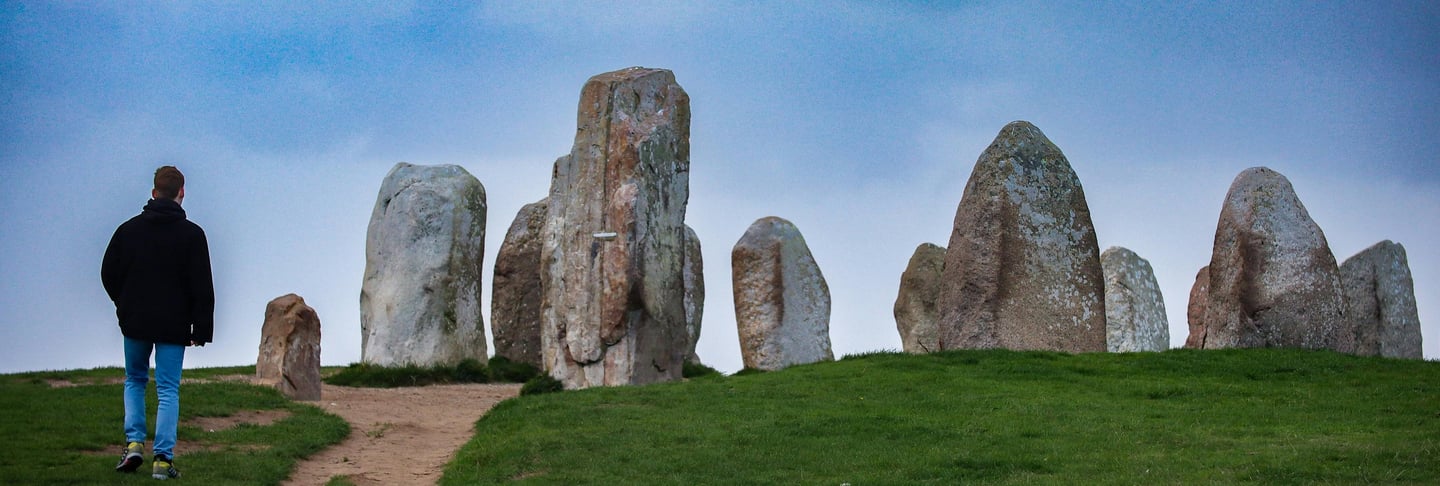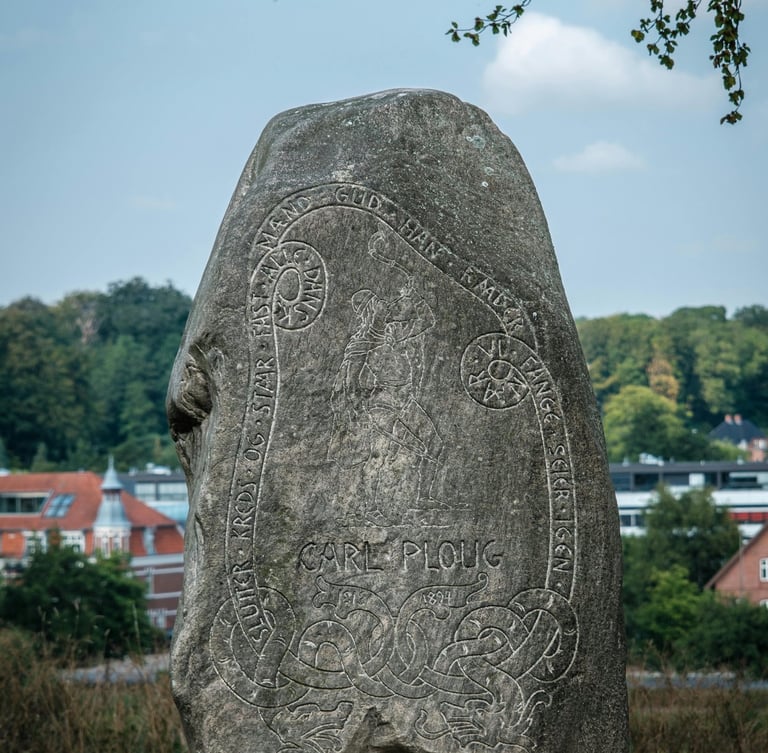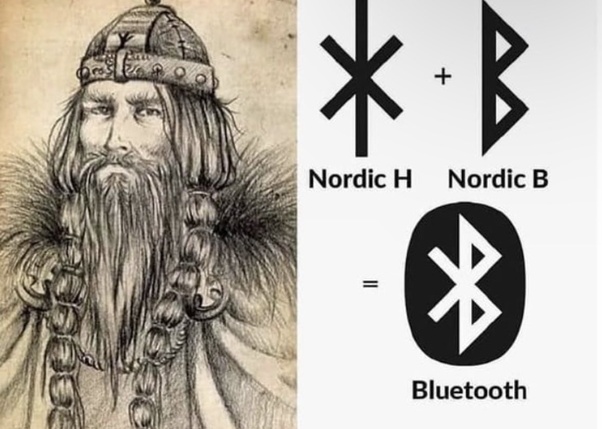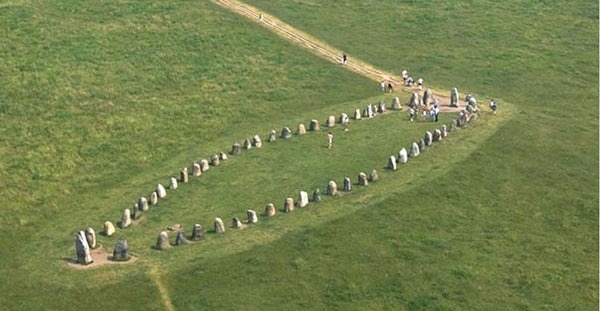Everything You Need to Know About the Vikings of Denmark, Sweden, Norway, and Finland
When I think about Danish Vikings, I'm struck by how their geographical location shaped their activities. Denmark's position, bordered by the North Sea and the Baltic Sea, made it a vital hub for Viking operations. In my research, I've found that Danish Vikings expertly utilized their proximity to continental Europe to establish trade routes and launch raids across the British Isles, Francia, and the Iberian Peninsula.
THE WORLD AROUND US
Peter
7/18/202412 min read


The Vikings of Denmark, Sweden, Norway, and Finland: A Personal Exploration
I was always deeply fascinated by the Viking Age, I've spent years researching the Norse seafarers who shaped European history from approximately 793 to 1066 AD. In this article, I'll share my insights into the distinct roles and contributions of Vikings from Denmark, Sweden, Norway, and Finland, highlighting their unique attributes and collective legacy. I'll also explore whether these Norsemen actually used the term "Viking" to describe themselves during their time.
Denmark: The Strategic Heart of Viking Activity
When I think about Danish Vikings, I'm struck by how their geographical location shaped their activities. Denmark's position, bordered by the North Sea and the Baltic Sea, made it a vital hub for Viking operations. In my research, I've found that Danish Vikings expertly utilized their proximity to continental Europe to establish trade routes and launch raids across the British Isles, Francia, and the Iberian Peninsula.
One aspect that fascinates me is how the kingdom of Denmark's rich agricultural lands and accessible waterways provided the resources necessary for sustained Viking expeditions. It's clear to me that this abundance was a key factor in their success.
In my studies of notable Danish Vikings, two figures stand out: King Harald Bluetooth and Sweyn Forkbeard. Harald Bluetooth played a crucial role in unifying Denmark and introducing Christianity. I find it particularly interesting how his reign marked a transition from paganism to Christianity, symbolized by the construction of significant monuments like the Jelling Stones. These stones, which I've had the privilege of seeing in person, bear inscriptions celebrating Harald's achievements and his conversion to Christianity.
Sweyn Forkbeard, on the other hand, impresses me with his military and political acumen. He became the first Viking king of England, showcasing the expansionist ambitions of Danish Vikings. His son, Cnut the Great, further expanded this legacy by establishing a North Sea Empire encompassing Denmark, England, and Norway. When I consider the scale of this achievement, it's clear to me that Danish Vikings were not just raiders but skilled politicians and empire-builders.
The cultural contributions of Danish Vikings are equally fascinating to me. They were instrumental in establishing the Danelaw in England, a region under Viking control that significantly influenced English culture, language, and legal systems. In my research, I've encountered numerous examples of Danish influence persisting through place names, linguistic elements, and legal practices integrated into the fabric of English society. It's a testament to the lasting impact of Danish Viking presence in England.
Welcome to Scandi Home Heaven! We believe in transparency and want to disclose that some of the links on our site are affiliate links. This means that at no additional cost to you, we may earn a commission if you click through and make a purchase. We only recommend products and services we have personally used and believe will add value to our readers.
Your support helps us continue to provide high-quality content. Thank you!
Sweden: The Traders and Explorers
When I turn my attention to Swedish Vikings, often referred to as Varangians, I'm struck by their distinct role as traders and explorers. Sweden's extensive network of rivers and proximity to the Baltic Sea facilitated the establishment of trade routes that extended deep into Eastern Europe, reaching as far as Byzantium and the Caspian Sea. In my mind's eye, I can picture Swedish Viking ships navigating these waterways, laden with goods and curiosity about distant lands.
The Swedish Viking heartland, particularly around Lake Mälaren, serves as a launching point for these extensive trade expeditions. When I visited this region, I was struck by how the landscape itself seemed to embody the spirit of exploration that characterized Swedish Vikings.
In my research on notable Swedish Vikings, Rurik stands out as a particularly intriguing figure. While semi-legendary, he's credited with founding the Rurik Dynasty, which laid the foundations for the Kievan Rus' state. This political entity, encompassing parts of modern-day Russia, Ukraine, and Belarus, was a significant cultural and economic bridge between Scandinavia and the Byzantine Empire. I find it fascinating how Swedish Vikings played such a crucial role in shaping Eastern European history.
Another aspect of Swedish Viking history that captivates me is the Varangian Guard, an elite unit of the Byzantine Army composed of Swedish Vikings. To me, this exemplifies the martial prowess and loyalty of these Norsemen, as well as their far-reaching influence.
The cultural exchanges facilitated by Swedish Vikings had a profound impact on the regions they interacted with. In my studies, I've observed how the blending of Norse and Slavic cultures contributed to developing unique artistic, architectural, and religious practices. The runestones, which served as memorials and records, provide valuable insights into the lives and beliefs of Swedish Vikings. I've had the opportunity to examine many of these runestones, and each one feels like a window into the past, offering glimpses of Viking life and beliefs.






Norway: The Pioneers of Exploration
Norwegian Vikings hold a special place in my research due to their exceptional seafaring skills and adventurous spirit. Norway's rugged coastline and fjords fostered a culture of maritime expertise that I find truly impressive. This expertise enabled the Norwegians to embark on voyages that took them far beyond the familiar waters of Scandinavia.
When I consider the political landscape of Viking Age Norway, I see a network of petty kingdoms and chieftaincies, often vying for power and influence. This fragmented political structure, in my view, contributed to the outward-looking nature of Norwegian Vikings, as ambitious individuals sought fame and fortune abroad.
In my studies of notable Norwegian Vikings, two figures stand out: Leif Erikson and King Harald Hardrada. Leif Erikson's voyage to North America, where he established a settlement known as Vinland (believed to be in present-day Newfoundland, Canada), never fails to amaze me. This journey, occurring around 1000 AD, predates Christopher Columbus's arrival in the Americas by nearly 500 years. To me, it highlights the remarkable navigational abilities and curiosity of Norwegian Vikings.
King Harald Hardrada, on the other hand, epitomizes the quintessential Viking warrior-king in my mind. His military campaigns across Europe, including his participation in the Varangian Guard and his eventual claim to the English throne, underscore the far-reaching ambitions and martial skills of Norwegian Vikings. When I read accounts of Harald's exploits, I'm struck by the sheer scale of his ambitions and achievements.
The cultural contributions of Norwegian Vikings are equally impressive to me. The sagas, epic narratives recounting the adventures and exploits of Norse heroes, serve as a vital literary legacy. In my research, I've spent countless hours poring over these sagas, finding them invaluable for preserving the history, mythology, and values of the Viking Age.
I'm also fascinated by the Viking longships, with their innovative design and craftsmanship. To me, they stand as a testament to the advanced maritime technology developed by the Norwegians. When I see reconstructions of these ships or study their remains in museums, I'm always in awe of the ingenuity and skill that went into their construction.
Finland: The Overlooked Participants
In my studies of the Viking Age, I've come to believe that Finland is often unfairly overlooked. While not typically considered part of the core Viking world, Finland's geographical location and cultural interactions with neighboring Scandinavian countries positioned it as a significant participant in the Viking Age. The Finnish coastlines along the Gulf of Finland and the Bothnian Sea provided access to the broader Baltic region, facilitating trade and cultural exchange.
I find the concept of Finnish Vikings somewhat contentious, as the region was inhabited by Finnic tribes who were culturally and linguistically distinct from the Norsemen. However, in my archaeological research, I've encountered evidence, such as burial sites and artifacts, that indicates Finnish tribes engaged in trade and interaction with their Viking neighbors.
One aspect of Finnish culture that I find particularly intriguing in relation to the Viking Age is the Kalevala, Finland's national epic. While it was compiled in the 19th century, I believe it contains elements that echo the mythologies and folklore of the Viking Age, suggesting a shared cultural milieu. When I read the Kalevala, I often find myself drawing parallels with Norse mythology and sagas.
In my view, the Finnish tribes contributed to the broader Viking network primarily through their participation in trade and exchange. I've examined artifacts such as weapons, jewelry, and household items found in Finnish burial sites that reflect a blend of local and Norse influences. This integration of Viking elements into Finnish culture is also evident in place names and folklore, which bear traces of the interactions between these two groups.
Viking Society and Culture
In my years of studying Viking society, I've come to understand it as a complex and stratified culture. The social structure was divided into distinct classes: jarls (nobles), karls (freemen), and thralls (slaves). The jarls were influential leaders who owned large estates and wielded considerable power. The karls, comprising farmers, craftsmen, and traders, formed the backbone of Viking society. Thralls, often captured during raids, were bound to serve their masters.
From my research into daily life in Viking society, I've learned that it revolved around farming, fishing, and trade. The harsh Scandinavian climate necessitated resourcefulness and adaptability, with communities relying on a mix of agriculture, animal husbandry, and maritime activities to sustain themselves. I find the longhouses, the typical dwelling of Viking families, particularly fascinating. These communal structures provided shelter and warmth during the long winters, and when I've visited reconstructed longhouses, I've been struck by their practicality and comfort.
Religion and mythology played a central role in Viking culture. In my studies of Norse mythology, I've encountered a rich pantheon of gods, giants, and mythical creatures. The gods, including Odin, Thor, Freyja, and Loki, were revered through rituals, sacrifices, and festivals. The concept of Yggdrasil, the World Tree connecting the various realms of existence, reflects the Norse cosmological view and never fails to captivate me with its complexity and symbolism.
One aspect of Viking religion that I find particularly intriguing is the transition from paganism to Christianity. This was a gradual process, influenced by political, social, and economic factors. In my research, I've encountered evidence of missionaries from Christianized parts of Europe, as well as Viking leaders who converted for political gain, facilitating the spread of Christianity. What fascinates me most is the coexistence of pagan and Christian practices during this transitional period, evidenced by artifacts and burial sites that combine elements of both religions.
Viking Technology and Innovation
The technological innovations of the Vikings never cease to amaze me. Their advanced maritime technology, in particular, was a cornerstone of their success. The longship, with its shallow draft, symmetrical design, and clinker-built construction, was a versatile vessel capable of navigating both open seas and shallow rivers. In my studies, I've come to appreciate how the longship's speed, agility, and ability to carry large crews made it ideal for raiding, trading, and exploration.
The navigation techniques employed by Vikings are equally impressive to me. They used landmarks, the sun, stars, and possibly even primitive compasses to guide their voyages. The sagas recount instances of exceptional seamanship, such as voyages through treacherous waters and across vast distances, showcasing the Vikings' navigational expertise. When I consider the challenges they faced and overcame, I'm in awe of their skills and bravery.
Viking weaponry is another area that fascinates me, reflecting their warrior culture and technological ingenuity. Swords, axes, spears, and bows were commonly used in battle, with each weapon crafted to balance durability and effectiveness. I've had the opportunity to examine many Viking weapons in museums, and I'm always struck by their craftsmanship and deadly efficiency. The Viking shield, typically made of wood and reinforced with iron, provided crucial protection during combat. In my mind, it's a perfect example of Viking pragmatism and skill.
The tactics employed by Viking warriors are equally intriguing to me. They used shield walls, swift raids, and psychological warfare to great effect. The element of surprise was often leveraged to devastating effect, allowing Viking raiders to overwhelm their opponents quickly and efficiently. When I study accounts of Viking battles, I'm impressed by their strategic thinking and adaptability.
The End of the Viking Age
As I've studied the decline of the Viking Age, I've come to understand it as a gradual process that occurred in the 11th century due to a combination of factors. The consolidation of stronger centralized kingdoms in Scandinavia reduced the need for raiding as a means of wealth acquisition. Additionally, increased resistance from European kingdoms, who had learned to defend against Viking incursions, made raiding less profitable and more hazardous.
In my view, the spread of Christianity also played a significant role in the decline of the Viking Age. As Norse societies converted to Christianity, the cultural and religious motivations for raiding diminished. The establishment of monastic orders and ecclesiastical structures further integrated Scandinavian societies into the broader Christian world, reducing the cultural isolation that had previously fueled Viking expansion.
The Term "Viking": A Historical Perspective
One question that has always intrigued me is whether the Norsemen of the Viking Age actually called themselves Vikings. In my research, I've found that the answer is nuanced. The word "Viking" derives from the Old Norse term "vikingr," which referred to a person participating in a "viking," or raid. Thus, "vikingr" was more of an occupation or activity rather than an ethnic or national identifier.
In the Old Norse sagas and runic inscriptions that I've studied, the term "viking" is used sparingly and contextually. It describes specific individuals or groups engaged in raiding and maritime expeditions. For instance, a Norseman might refer to going "a-viking," meaning to set out on a raid, but they would identify themselves primarily by their regional or tribal affiliations, such as Dane, Swede, Norwegian, or more locally, as a member of a particular clan or family.
In my examination of contemporary sources from outside Scandinavia, such as the Anglo-Saxon Chronicle, I've found that these raiders were often referred to more broadly as Northmen, Norsemen, or Danes, depending on their origin. These terms were used to describe the groups collectively known today as Vikings, emphasizing their geographic origins rather than their activities.
Conclusion
As I reflect on my years of studying the Vikings of Denmark, Sweden, Norway, and Finland, I'm struck by how each group contributed uniquely to the Viking Age, leaving a legacy that continues to captivate and inspire. Danish Vikings were strategic raiders and kings, Swedish Vikings were renowned traders and explorers, Norwegian Vikings were pioneering adventurers, and Finnish tribes played a significant role in the broader Viking network.
The term "Viking" itself, used historically to describe those engaged in raiding, underscores the diverse and dynamic nature of these Norsemen. In my view, it's this diversity and dynamism that makes the Viking Age such a fascinating period of history to study.
As I continue my research, I'm constantly amazed by new discoveries and interpretations that shed light on this transformative period in European history. The Vikings' impact on language, law, technology, and culture resonates to this day, and I believe there's still much to learn from their legacy. Whether it's examining a newly unearthed artifact, deciphering a runic inscription, or reinterpreting a saga, the world of Viking studies never ceases to excite and challenge me.
In conclusion, the Vikings were far more than just raiders and warriors. They were explorers, traders, craftsmen, and statesmen who left an indelible mark on the world. Their story is one of ambition, innovation, and adaptation, and it's a story that I believe will continue to fascinate and inspire for generations to come.
Welcome to my Designs
Welcome to a world of creative expression! Based in the heart of Copenhagen but reaching customers worldwide, I bring over 500 unique designs to life on t-shirts, hoodies, mugs, and more. Passionate about graphic design, I combine Nordic inspiration with global appeal to offer stylish, high-quality merchandise through Shopify/Printify and Teepublic. Whether you’re looking for a cozy sweatshirt or a personalized candle, each product is crafted to make everyday moments extraordinary.
Explore, express, and enjoy!
Welcome to my world of creative expression! Based in the heart of Copenhagen but reaching customers worldwide, I bring over 500 unique designs to life on t-shirts, hoodies, mugs, and more. Passionate about graphic design, I combine Nordic inspiration with global appeal to offer stylish, high-quality merchandise through Shopify/Printify and Teepublic. Whether you’re looking for a cozy sweatshirt or a personalized Coffee Mug, each product is crafted to make everyday moments extraordinary.
Explore, express, and enjoy!
Advertisment for our Merchndise Shop














